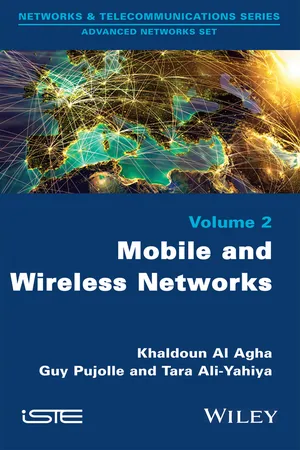In this chapter, we provide a brief overview of mobile and wireless networks (MWN). The objective is to present the background and context necessary for understanding subsequent chapters. We review the history of MWN, enumerate their applications and compare them in order to see the effect of such technology not only on the market drivers but also on research domain areas.
1.1. Mobile and wireless generation networks
The International Telecommunication Union (ITU) launched International Mobile Telecommunications (IMT-2000) as an initiative to cover high-speed, broadband and IP-based mobile systems featuring network-to-network interconnection, feature/service transparency, global roaming and seamless services independent of location. IMT-2000 aims to bring high-quality mobile multimedia telecommunications to a worldwide mass market by increasing the speed and ease of wireless communications, responding to problems due to increased demand to pass data via telecommunications, and providing “anytime, anywhere” services.
Two partnership organizations were born out from the ITU–IMT-2000 initiative: the Third Generation Partnership Project (www.3gpp.org) and the Third Generation Partnership Project 2 (www.3gpp2.org). The 3GPP and 3GPP2 developed their own version of 2G, 3G and later mobile systems. In parallel, the Institute of Electrical and Electronics Engineers (IEEE) was developing proper versions of the wireless networks that can be compared functionally with those of 3GPP and 3GPPP2 and their technology-based generations can be crossed with those of 3GPP and 3GPP2. Their terminologies are different but the goal is the same, which is to develop new technologies that make use of advances in the area of wireless and mobile technologies. This is why, we will summarize all the generations developed by these organizations as a path of evolution in the world of mobile and wireless networking.
1.1.1. First generation mobile technology: 1G
First-generation cellular networks (1G) were analog-based and limited to voice services and capabilities. Compared to today’s technology, 1G technology was vastly inferior. In the late 1970s and early 1980s, various 1G cellular mobile communication systems were introduced; the first such system, the Advanced Mobile Phone System (AMPS) was introduced in the United States in the late 1970s. Other 1G systems include the Nordic Mobile Telephone System (NMTs) and the Total Access Communications System (TACS). While these systems offer reasonably good voice quality, they provide limited spectral efficiency. The evolution toward 2G was thus necessary to overcome the drawback of such technology.
1.1.2. Second generation mobile technology: 2G
The second-generation (2G) digital systems promised higher capacity and better voice quality than their analog counterparts. The two widely deployed 2G cellular systems are Global System for Mobile Communications (GSM) and Code Division Multiple Access (CDMA) that was originally known as American Interim Standard 95, or IS-95 and is now called cdmaOne. Both the GSM and CDMA camps formed separate 3G partnership projects (3GPP and 3GPP2, respectively) to develop IMT-2000-compliant standards based on the CDMA technology. GSM differs from 1G by using digital cellular technology, Time Division Multiple Access (TDMA) transmission methods and slow-frequency hopping for voice communication. In the United States, 2G cellular standardization process utilized direct-sequence CDMA with phase-shift keyed modulation and coding.
There was an evolution of main air interface-related enhancements to GSM: (1) higher data-rates for circuit-switched services through aggregation of several time-slots per TDMA frame with high-speed circuit-switched data (HSCSD); (2) general packet radio service (GPRS), which had efficient non-real-time packet-data traffic support. GPRS reached peak data rates of up to 140 Kbps when a user aggregated all timeslots; and (3) enhanced data rates for global evolution (EDGE) increased data rates up to 384 Kbps with high-level modulation and coding within the existing carrier bandwidth of 200 kHz.
1.1.3. Third generation mobile technology: 3G
Further evolution of the GSM-based systems is handled under 3GPP to define a global 3G Universal Mobile Telecommunications System (UMTS). The main component of this system is the UMTS Terrestrial Radio Access Network (UTRAN) based on Wideband Code Division Multiple Access (WCDMA) radio technology, since it uses 5 MHz bandwidth and GSM/EDGE Radio Access Network (GERAN) based on (GSM) enhanced data rates.
3GPP2 implemented CDMA2000 in the 1.25 MHz bandwidth, which increased voice and data services and supported a multitude of enhanced broadband data applications, such as broadband Internet access and multimedia downloads. This technology also doubled user capacity over cdmaOne, and with the advent of 1xRTT, packet data was available for the first time.
The 3GPP2 first introduced high-rate packet data (HRPD), termed CDMA20001xEV-DO. This standard enables high-speed, packet-switched techniques designed for high-speed data transmissions, enabling peak data rates beyond 2 Mbps. 1xEV-DO expanded the types of services and applications available to end users, enabling carriers to broadcast more media-rich content.
The 3GPP enhanced the WCDMA system, providing high-speed downlink packet access (HSDPA) that brought spectral efficiency for higher speed data services in 2001. Then, High-Speed Uplink Packet Access (HSUPA) was introduced in 2005. The combination of HSDPA and HSUPA is called HSPA. The latest HSPA is HSPA+, which resulted from adding multiple input/multiple output (MIMO) antenna capability and 16QAM (Uplink)/64QAM (Downlink) modulation. Coupled with improvements in the radio access network for continuous packet connectivity, HSPA+ allows uplink speeds of 11 Mbps and downlink speeds of 42 Mbps.
As the successor of CDMA2000, CDMA2000 1xEV-DO Release 0 provides peak speeds of up to 2.4 Mbps with an average user throughput of between 400 and 700 Kbps. The average uplink data rate is between 60 and 80 Kbps. Rel. 0 makes use of existing Internet protocols, enabling it to support IP-based connectivity and software applications. In addition, Release 0 allows users to expand their mobile experience by enjoying broadband Internet access, music and video downloads, gaming and television broadcasts.
1xEV-DO Release 0 has been revised to produce Revision A (Rev-A), which increases peak rates on reverse and forward links to support a wide-variety of symmetric, delay-sensitive, real-time, and concurrent voice and broadband data applications. It also incorporates orthogonal frequency-division multiple access (OFDMA) technology to enable multicasting (one-to-many) for multimedia content delivery. As the successor of Rev-A, 1xE...
